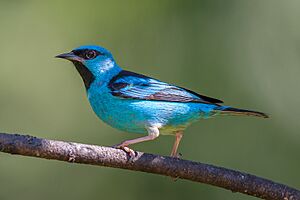Blue dacnis facts for kids
Quick facts for kids Blue dacnis |
|
|---|---|
 |
|
| Adult male | |
 |
|
| Adult female in São Paulo, Brazil | |
| Conservation status | |
| Scientific classification | |
| Genus: |
Dacnis
|
| Species: |
cayana
|
 |
|
| Synonyms | |
|
|
The blue dacnis or turquoise honeycreeper (Dacnis cayana) is a small, colorful passerine bird. It belongs to the tanager family. You can find this bird from Nicaragua to Panama, on the island of Trinidad, and in South America. Its range goes south to Bolivia and northern Argentina. It is a common bird in many parts of its South American home.
About Its Name
The scientific name for the blue dacnis is Dacnis cayana. This name was given by the Swedish naturalist Carl Linnaeus in 1766. The word cayana comes from Cayenne, a place in French Guiana. This is where the first bird of this type was found.
There are eight different types, or subspecies, of the blue dacnis. These subspecies are slightly different depending on where they live:
- D. c. callaina – found in west Costa Rica to southwest Panama.
- D. c. ultramarina – lives from Honduras to northwest Colombia.
- D. c. napaea – found in north and north-central Colombia.
- D. c. baudoana – lives in southwest Colombia and west Ecuador.
- D. c. caerebicolor – found in central Colombia.
- D. c. cayana – lives in east Colombia to French Guiana, Trinidad, and north/central Brazil.
- D. c. glaucogularis – found from south Colombia through east Ecuador and east Peru to north/east Bolivia.
- D. c. paraguayensis – lives in east/south Brazil, east Paraguay, and northeast Argentina.
What It Looks Like
The blue dacnis is about 12.7 centimeters (5 inches) long. It weighs about 13 grams (0.46 ounces). Even though it's sometimes called a "honeycreeper," it doesn't have the long bill that true honeycreepers have.
The adult male blue dacnis is a beautiful turquoise blue. It has black feathers around its eyes, on its throat, and on its back. Its wings and tail are black, but they have turquoise edges.
The female and young birds look different. They are mostly green. Their heads are blue, and their undersides are a lighter green. Their brown wings also have green edges. The blue dacnis makes a thin tsip sound.
Where It Lives
The blue dacnis lives in forests and other wooded areas. You can also spot them in gardens and parks. They are found across a wide range in Central and South America.
How It Lives
Blue dacnis birds build a strong, cup-shaped nest in a tree. The female bird usually lays two or three whitish eggs. These eggs often have grey spots. The female sits on the eggs to keep them warm. The male bird helps by bringing food to the female while she is nesting.
These birds are social, meaning they like to be with other birds. They mostly eat insects. They find these insects on leaves, flowers, or in plants like bromeliads. They also eat a lot of fruit, such as berries, figs, and bananas. They usually swallow the fruit whole. They rarely drink nectar from flowers.


